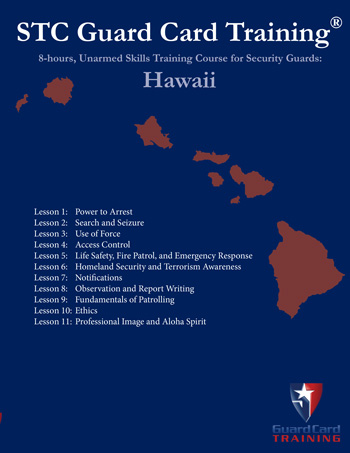Hawaii Security Guard Training Manuals
Hawaii Board of Private Detectives and Guards (BPDG)
NOTE: These training manuals are intended for use as part of an instructor-led course in accordance with the Hawaii Revised Statutes and Administrative Codes. This manual may be used exclusively by a BPDG Licensing-Certified Security Guard instructor in approved and licensed training facilities.
The 8-hours, Unarmed Skills Training Course for Security Guards: Hawaii must be completed before the Unarmed Security Guard Registration certificate and identification card are issued.
Price: $84.99 (plus tax, shipping/handling)

8-hours, Unarmed Skills Training Course for Security Guards: Hawaii
252 pages. This training manual is intended for use as part of an instructor-led course in accordance with Hawaii Revised Statutes Chapter 436B – Professional and Vocational Licensing Law, §463-10.5 Guards; registration, instruction, training, testing, and continuing education required; renewal of registration. This course must be provided by a BPG licensed Guard Instructor. The complete 8-hours, Hawaii Unarmed Security Guard Skills Training Course is divided into eleven (11) lessons. The coursework must be completed before the Unarmed Security Guard Training Certificate is issued and the guard begins work.
Every lesson includes Knowledge Checks and References for further study.
This manual is divided into eleven (11) lessons:
- Lesson 0. Introduction
- Lesson 1. Power to Arrest
- Lesson 2. Search and Seizure
- Lesson 3. Use of Force
- Lesson 4. Access Control
- Lesson 5. Safety, Fire and Emergency Response
- Lesson 6. Homeland Security
- Lesson 7. Notifying Authorities
- Lesson 8. Observation and Reporting
- Lesson 9. Fundamentals of Patrolling
- Lesson 10. Professional Ethics
- Lesson 11. Professional Image and Aloha Spirit
Lesson 0, Introduction
Back to topObjectives:
- Understand the requirements to become a security guard in the State of Hawaii.
- Responsibility and Authority of a Security Guard
- Regulations Overview
Lesson 1, The Power to Arrest
Back to topObjectives:
- Describe the law of arrest as it pertains to private security in Hawaii.
- Differentiate the fundamentals of criminal law as it pertains to private security.
- Recognize the Hawaii State Revised Statutes.
- Interpret the appropriate use of reasonable force.
- Explain differences between detention and arrest.
- Summarize and define false imprisonment.
Lesson 2, Search and Seizure
Back to topObjectives:
- Define seizure as it applies to private citizens.
- Describe the limits of search and seizure as it applies to private security in Hawaii.
- Interpret the Hawaii State Revised Statutes.
- Summarize laws regarding interrogation.
- Identify common forms of evidence.
- Explain proper care and handling of evidence.
- Summarize the correct procedure to secure a scene.
- Describe common legal issues regarding evidence.
- Collect appropriate information from witnesses.
- Identify types of evidence.
Lesson 3, Use of Force
Back to topObjectives:
- Paraphrase the responsibilities of a private security guard.
- Recognize the Hawaii State Revised Statutes.
- Interpret the appropriate use of reasonable force.
- Describe the Use of Force Continuum/Ladder.
- Explain the use of restraint techniques and their implications.
- Explain the use of deadly force.
- Describe the use of force in property defense.
- Explain escalation and de-escalation techniques in the use of force.
Lesson 4, Access Control
Back to topObjectives:
- Describe access control.
- Interpret the fundamentals of manual access control systems.
- Interpret the fundamentals of automated access control systems.
- Apply identification procedures to on-site personnel.
- Explain the fundamentals of alarm systems. Describe the fundamentals of trespass.
Lesson 5, Life Safety, Fire Patrol, and Emergency Response
Back to topObjectives:
- Understand fire safety.
- Understand the three elements necessary for fire.
- Recognize common fire safety hazards.
- Safely take action in the event of a fire.
- Understand fire life safety.
- Understand various fire protection systems.
Lesson 6, Homeland Security Issues and Procedures
Back to topObjectives:
- Identify functions of major counterterrorism agencies.
- Describe the nature of terrorism.
- Explain the goals of terrorism.
- Describe the differences between homegrown violent extremists and international terrorism.
- Identify the common homegrown violent extremists and organization goals.
- Identify suspicious behavior.
- Better protect their post from terrorist threats.
Lesson 7, Notifying Public Authorities
Back to topObjectives:
- Distinguish the importance of effective internal and external communication.
- Summarize the importance of reading and understanding post orders.
- Describe the need for confidentiality of protocols and contact information.
- Demonstrate the basic information to collect in an emergency.
- Explain how to make a direct an efficient call for assistance.
- Effectively use common communication systems.
Lesson 8, Observation and Reporting
Back to topObjectives:
- Write an effective report.
- Take descriptive and useful field notes.
- Properly employ all senses in observation.
- Conduct an efficient and productive patrol.
- Conduct a thorough area search.
Lesson 9, Fundamentals of Patrolling
Back to topObjectives:
- Apply appropriate patrolling techniques and methods.
- Describe how to handle suspicious activity.
- Explain how to ask appropriate questions.
- Apply accident and fire prevention techniques.
Lesson 10, Professional Ethics
Back to topObjectives:
- Understand the principles of ethical behavior.
- Describe how to avoid conflicts of interest.
- Identify ethical violations.
- Explain how to report unethical behavior.
Lesson 11, Professional Image and Aloha Training
Back to topObjectives:
- Know how to project a friendly, professional image.
- Describe the importance of positive public relations.
- Demonstrate Command Presence.
- Explain the importance of maintaining a clean, sharp uniform.
- Embody Aloha Spirit.
- Define good public relations.
Licensing Contact
For more information on our licensing programs, please contact:


